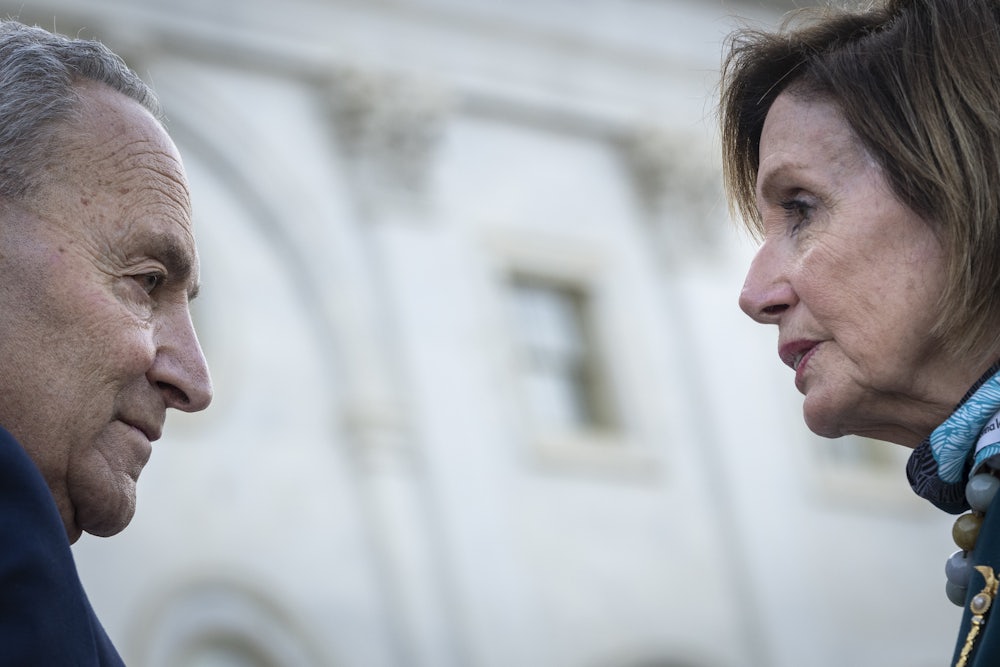It’s rare that Democrats and Republicans agree on much, but in political circles there’s a pretty widespread agreement on what the 2022 midterm elections will be: an undeniable shellacking for the Democratic Party. The common expectation is that Democrats will lose their small majority in the House of Representatives and face a knife fight to keep control of the Senate. There’s plenty of historical evidence that the party that controls the White House will win congressional seats and perhaps even control of some governors’ mansions. With President Biden’s approval ratings underwater, it looks like 2022 will be no different.
Still, it’s also conceivable that expectations won’t meet reality. Democrats could avoid a complete drubbing and either retain their majorities in both chambers or at least keep it close.
Below are the three overarching scenarios that could become the 2022 midterm elections.
Best Case for Democrats
The hedge that both the Biden White House and veteran Democratic campaign officials are making is that after an undeniably painful legislative process, Democrats will pass some version of the Biden administration’s Build Back Better social spending programs. From there, candidates across the country will be able to run on how Democrats passed a Covid-19 relief bill, the biggest surface transportation infrastructure bill in decades, and a massive social spending bill.
The rosiest scenario for Democrats depends on everything going well for them (when has that ever happened?). So Covid goes away once and for all, Americans uniformly benefit from and appreciate the infrastructure deal, and somehow lawmakers pass Biden’s expansive Build Back Better social spending package, which voters also learn to love. Republican enthusiasm will have to dip, and Democratic enthusiasm will have to jump as well. Under these conditions, Democrats would have a very strong case to make for why they deserve reelection across the board.
Still, it’s hard to picture Democrats not losing at least a few congressional seats—three House Democrats, for instance, announced that they wouldn’t run for another term the week of Christmas. Overall, 23 House Democrats have opted not to run for reelection, while just 13 House Republicans have made the same choice.
But how Republicans have approached redistricting offers at least some hope, said Celinda Lake, a Democratic pollster and political strategist. Republicans “could have chosen to maximize this year by going in and spreading their votes and trying to pick up as many seats as possible. That’s not what they’ve chosen in these states. Ironically, what they’ve chosen is to protect their incumbents and pack their voters,” Lake said. “So we’re not going to lose as many seats from redistricting as people think and as we might have lost, honestly.”
If you’re a Democrat, things get brighter once you consider the Senate and gubernatorial elections. In the Senate, New Hampshire Governor Chris Sununu’s decision not to run for reelection scrambled carefully laid Republican plans to pit the incumbent, first-term Democratic Senator Maggie Hassan against one of the most popular governors in the country.
There are pickup opportunities for Democrats as well: Pennsylvania, Wisconsin, and North Carolina are all states with Democratic governors and either an open Senate seat or one with a Republican who won his previous election by the skin of his teeth. That could be different in 2022 if Democrats run disciplined, galvanizing campaigns that strongly contrast their candidates with increasingly fractured Republicans. “I think there are some real opportunities in the Senate and some real opportunities in the state races, but I think Congress is tougher,” Lake said.
Some of it will depend on what candidates focus on. “I think that if a Democrat’s going to be able to win in these tough districts, they’re going to have to focus not on the national party but on the district itself,” said John Breaux, a former senator and chair of the Democratic Senatorial Campaign Committee. Democrats should say, Breaux continued, “‘Look, I’m going to put the district first, not the party first.’”
Things could be even better in the gubernatorial arena. In deep-blue Maryland, Republican Governor Larry Hogan, one of the most popular governors in the country, is term-limited (and likely going to run a long-shot campaign for the presidency). In almost equally Democratic Massachusetts, Republican Governor Charlie Baker, the most popular governor in the country, has decided not to run for reelection in the face of a tough primary. It’s not unusual for Republicans to win the governor’s race in Massachusetts, but given the reliably Democratic lean of the state, it’s entirely possible to flip control of that governor’s mansion, even in a tough midterm cycle for liberals.
It’s easy for political junkies to forget that Democrats already have a list of accomplishments to run on, Breaux said. “I would really emphasize the infrastructure legislation—how important it was, and what they’ve done on the coronavirus, and the financial assistance for people who are losing their jobs, and really focus locally and not so much on the other issues,” he said.
Worst Case for Democrats
No serious person can sugarcoat it. Republicans are the heavy favorites to make gains in 2022. In the House, gerrymandered districts—many of them helpful for Republicans—make the entire map a little more favorable for Republicans than it otherwise would be.
House Minority Leader Kevin McCarthy—the likely speaker of the House if Republicans retake control—has predicted that Republicans could flip 60 congressional seats in 2022 (Democrats currently control 221 seats in Congress while Republicans have 213 seats).
Caucus leaders always paint an overly rosy picture even if they know electoral doom is nigh, but it’s possible that McCarthy’s prediction may not be that far-off. In 2010, Democrats lost 63 seats to the Tea Party wave. That was when a sitting Democratic president was fighting to pass a sweeping domestic policy proposal and his approval ratings were below 50 percent. It’s not a carbon copy, but some of the factors of the current political environment are chillingly similar to those of 2010 for Democrats. One difference, though, is there were more swing districts and moderate lawmakers then than there are today. Everything was a little less polarized.
Republicans are also optimistic that they can knock out incumbents in historically red-leaning states like Arizona and Georgia. Democratic party officials are entirely aware that Senators Mark Kelly and Raphael Warnock have to run for reelection without having been in the Senate very long and in environments that haven’t been overly friendly to Democrats recently.
It’s also conceivable that Republicans pick up a handful of governors’ mansions in states like Kansas, Michigan, Wisconsin, Nevada, and Maine while retaining ones in Ohio, Texas, and Georgia.
In the toughest states, Republican Governors Association Communications Director Jesse Hunt argued, “Democrats are going to have to spend a good chunk of their time playing defense and spending a good chunk of the resources they do have protecting vulnerable Democrat governors.”
Most Realistic Scenario
The realistic scenario for 2022 is somewhat in the middle, but only somewhat. Assuming Biden’s poll numbers pick up at least a little bit and Democrats pass some watered-down version of Build Back Better (which seems likely), they will be in a better position than they would be if the election were tomorrow. But that still isn’t enough to fend off the larger forces at play that give Republicans an advantage: gerrymandering, an energized conservative base, and a general frustration with Democratic legislative infighting that depresses Democratic turnout.
There are still important factors taking shape that will decide the midterm elections. Lake said: “There are three variables. One is: What does reapportionment do? Two, what’s the direction of the economy in May and June of next year, not right now? Not right now but May and June of next year. And number three, do we pass Build Back Better, then go out and sell these packages? Because a lot of people don’t know what’s in the infrastructure bill, much less Build Back Better.”
Harrison Hickman, a Democratic pollster, suggested that one very likely outcome is that some Republican candidates trip over themselves in moderately difficult or otherwise easy races. Republicans could end up nominating Trumpist and serial-2020-election–liar Kari Lake for governor in Arizona, bringing all her baggage along for the ride. Or in Georgia, despite all the hype, Herschel Walker might not be a strong enough candidate to knock out Warnock in a year with very high turnout on both sides. So in this scenario, there are small pockets of luck for Democrats. The result is similar to what Americans are experiencing now from their government: mostly gridlock, partisan fighting, and legislative standoffs.
“I think the most realistic case is the Republicans will probably either narrowly take control of the House or the Democrats will narrowly control the House,” Hickman said. “I think that’s the most likely scenario, that there’s not going to be anybody who has a dominant majority in the House. The same in the Senate … the most likely scenario is going to be divided government, but the absolute most likely scenario is going to be a government that struggles to do more than the basic stuff.”
Of course, voters could opt to buck the pattern and keep the incumbent party in power. That would require a level of attention and faith in government that doesn’t seem to exist right now among the majority of Americans.








